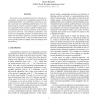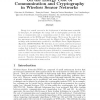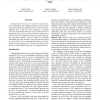CSFW
2007
IEEE
15 years 1 months ago
2007
IEEE
We present a new mechanized prover for showing correspondence assertions for cryptographic protocols in the computational model. Correspondence assertions are useful in particular...
WIMOB
2008
IEEE
15 years 1 months ago
2008
IEEE
Energy is a central concern in the deployment of wireless sensor networks. In this paper, we investigate the energy cost of cryptographic protocols, both from a communication and ...
100
click to vote
CSFW
2009
IEEE
15 years 2 months ago
2009
IEEE
One of the important challenges when designing and analyzing cryptographic protocols is the enforcement of security properties in the presence of compromised participants. This pa...
CSFW
2009
IEEE
15 years 2 months ago
2009
IEEE
Cryptographic protocols are crucial for securing electronic transactions. The confidence in these protocols can be increased by the formal analysis of their security properties. ...
CTRSA
2010
Springer
15 years 2 months ago
2010
Springer
Typical security models used for proving security of deployed cryptographic primitives do not allow adversaries to rewind or reset honest parties to an earlier state. Thus, it is c...
IEEEARES
2010
IEEE
15 years 2 months ago
2010
IEEE
Formal verification can give more confidence in the security of cryptographic protocols. Application specific security properties like “The service provider does not loose mo...
CADE
2005
Springer
15 years 7 months ago
2005
Springer
We prove that, if the initial knowledge of the intruder is given by a deterministic bottom-up tree automaton, then the insecurity problem for cryptographic protocols with atomic ke...
WWW
2007
ACM
15 years 8 months ago
2007
ACM
Cryptographic protocols are useful for trust engineering in Web transactions. The Cryptographic Protocol Programming Language (CPPL) provides a model wherein trust management anno...




